We were lucky to have a nice sunny day for my new bees' first complete day in their new hive homes. They spent a lot of time today getting their bearings and flying close around the hives, though some were already busy bringing in pollen. This is a little video just to give an idea of the pleasantness of watching and being around bees. Please excuse the unevenness of the sound volume- I must have blocked the microphone holes with my finger on the camera for a little while.
Friday, April 30, 2010
Thursday, April 29, 2010
The new honeybees are hived.
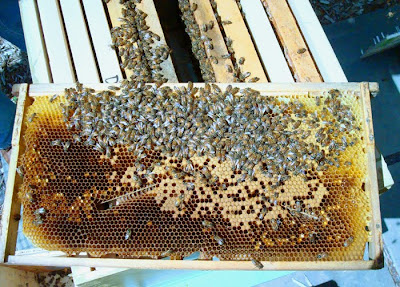 Today I installed the two 'nuc' colonies of honeybees into their waiting new hives. My friend Cris helped me., and he was not afraid. We weren't sure what kind of mood the bees would be in when we pried open their shipping boxes, so we had the smoker ready and had veils and gloves on just in case the bees were unhappy about having been cooped up in a little box for 2 days.
Today I installed the two 'nuc' colonies of honeybees into their waiting new hives. My friend Cris helped me., and he was not afraid. We weren't sure what kind of mood the bees would be in when we pried open their shipping boxes, so we had the smoker ready and had veils and gloves on just in case the bees were unhappy about having been cooped up in a little box for 2 days.As it turns out, the bees were unbelievably sweet natured, and our precautions seemed a bit overdone. Neither Cris nor I were stung despite handling thousands of bees on the ten frames that had been shipped to me in the two nucs.
Here we are, installing the frames of bees and brood into my waiting hive boxes along with some new frames as well, to fill the spaces out. Click on each photo to enlarge and see it better. The nucs came with lots of nice looking brood in capped cells, developing into new young bees which emerge over the coming days. The top picture above shows a nice patch of capped worker bee brood being covered and cared for by nurse bees.
We did get to check the two queens which were in their little queen cages and active. Over the next couple of days the worker bees will continue to chew off the little candy 'door' on the queen cages and release the queens each in their own hive. By that time the bees will be familiar with their new queen's scent and will accept her. In a couple of days I will check to see whether the queens have been released from their cages yet.


After getting the frames of bees and the queen cages safely situated in the two hives, I made sure they each had a full frame of honey (saved from my old hive) and also some sugar syrup as a tonic for them after their journey of hundreds of miles rumbling down the highway to get to me from down south in Georgia. My thanks to Don Kuchenmeister, the "Fat Bee Man", for shipping such wonderful healthy bees to me!
I named the hives Esperanza (which means Hope) on the left, and Aurora (which means Morning) on the right. They are named after two of Cris' sisters, all of whom seem to have been blessed with lovely names...

Labels:
honeybees
Wednesday, April 28, 2010
The new Honeybees are here!!

 I am SO EXCITED!! My two nuc/colonies of honeybees have arrived, unexpectedly early. It's a good thing I had already gotten everything prepared ahead of time. Each of the two boxes contains five frames full of bees plus a queen in a little cage for her travel protection. Literally thousands of honeybees.
I am SO EXCITED!! My two nuc/colonies of honeybees have arrived, unexpectedly early. It's a good thing I had already gotten everything prepared ahead of time. Each of the two boxes contains five frames full of bees plus a queen in a little cage for her travel protection. Literally thousands of honeybees.I will be installing them into their brand new hives tomorrow afternoon once the day warms up. Meanwhile, they remain in their travel boxes overnight on my kitchen table....humming quietly and waiting to start their new adventure tomorrow.
Here is a little video I took today to capture the fascinating sight and sound of the boxes full of bees. If you click on it and watch it directly on YouTube, it will be a nicer sized (uncropped) view...
Labels:
honeybees
Monday, April 26, 2010
I've got stinging nettle
A few days ago i was surprised to find a young new scattering of wild stinging nettle growing near the lilac bush, amongst some other 'weeds'. It was already about a foot high. I've never had stinging nettle in my yard before. The next day I had the opportunity to ask my herb-wise friend Lauren about how to use and prepare nettle for both eating and making nettle tea. Nettle is supposed to be a very beneficial herb and tonic, also a highly nutritional green. I knew Lauren had been using nettle for years and loved it. Here is an informative Wikipedia page on stinging nettle and its uses.
Lauren gave me a lot of good information about how to use stinging nettle. Of course one must be very careful when coming into contact or harvesting nettle, for the tiny barbs are quite painful- I knew this from experience years ago! Once the nettle leaves and stems are steamed, cooked, or dried for tea, they completely lose their ability to sting.
I plan to try drying some nettle for use as a tea, and also hope eventually to have enough harvest of the tender plant tips to try cooking it like a Spring green, in the manner of spinach. Apparently the taste is delicious to some people and not to others. We shall see.
Unfortunately, before I had a chance to caution my husband about mowing the nettle down with the lawn mower, they were already mowed! However, being a weed I am sure they will grow up again in the same spot if allowed to, and I also found a few more undamaged shoots nearby that had escaped the mower. These I photographed...


Lauren gave me a lot of good information about how to use stinging nettle. Of course one must be very careful when coming into contact or harvesting nettle, for the tiny barbs are quite painful- I knew this from experience years ago! Once the nettle leaves and stems are steamed, cooked, or dried for tea, they completely lose their ability to sting.
I plan to try drying some nettle for use as a tea, and also hope eventually to have enough harvest of the tender plant tips to try cooking it like a Spring green, in the manner of spinach. Apparently the taste is delicious to some people and not to others. We shall see.
Unfortunately, before I had a chance to caution my husband about mowing the nettle down with the lawn mower, they were already mowed! However, being a weed I am sure they will grow up again in the same spot if allowed to, and I also found a few more undamaged shoots nearby that had escaped the mower. These I photographed...


Labels:
gardening
Thursday, April 22, 2010
tiny sprouts in the garden
This is one of my favorite things about the garden... when the seed has sprouted and fresh green shoots appear with their first tender bright green leaves against the black soil. I love how completely distinctive the plant varieties are from each other, even at this early stage.
I couldn't resist taking a few 'baby portraits' in the vegetable garden in the afternoon sun.

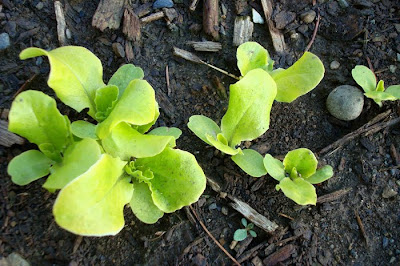

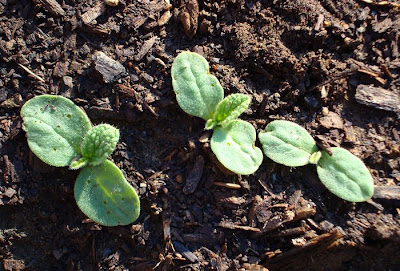
I couldn't resist taking a few 'baby portraits' in the vegetable garden in the afternoon sun.
Spinach...

Black seeded Simpson leaf lettuce...

French breakfast radishes...

Borage... (especially planted for my bees)

Labels:
gardening
Wednesday, April 21, 2010
Wednesday, April 14, 2010
The leafcutter bee block is up...

I asked Dave of Dave's Bees to make me a special nesting block for leafcutter bees.
Leafcutter bees line and seal their egg chambers with circular pieces of green leaves that they chew off with their precise mandibles. This is different from the mason bees, who use mud to seal their egg cocoon chambers. Leafcutter bees supposedly like slightly smaller and shorter tubes (1/4" diameter x 4" length) than mason bees like (5/16" diam. x 6" length). They also do their nesting just a bit later in the Spring than the mason bees typically do, from what I have read. So Dave made me a really nice nesting block with the requested sized holes (lined with parchment so as to discourage mites and fungus by replacing the liner each year).
I put it up underneath my other two boxes. The new leafcutter bee box is at the bottom in the photo, on our back kitchen porch post. The morning sun shines right at the fronts of the nesting blocks, warming up the bees nicely on chilly mornings for a couple of hours. Again, I stapled on chicken wire to keep any hungry woodpeckers from getting the bees or cocoons. It will be very interesting to see who, if anyone, moves into the new bee block with the smaller holes. (Clicking the blog pictures will enlarge them)
Here just before sunset today I got a couple of shots of the Osmia taurus mason bee going in and out of one of the tubes. This little bee must be living around here and discovered the nice nesting tubes and moved in right alongside my blue orchard mason bees! They seem to be getting along just fine. It's nice to have two different species to watch. The first photo shows her flying in, the next photo is when she emerged from the tube to do another pollen run. It's very hard to photograph them, as they seldom seem to stay still for a second, unlike honeybees who often laze about photogenically. ;)


And here is my first video of my solitary bees using the nest boxes on my kitchen porch!:
Labels:
mason and solitary bees
Fabre and my dreams as a 12 year old girl

Too often I find that in garden discussions, the subject of insects is limited to referring to them as 'pests' and subsequently discussing practical ways to kill insects in one way or another. I find this attitude a bit odd.
Consider that experienced gardeners seem fully aware of the direct relationship between their healthy plants and the soil conditions and nutrients that directly effect them. They recognize that plants do not exist in complete isolation from their natural environment, that there is in fact an ecosystem that is best kept in healthy balance if one desires optimum results in the garden. Yet beneficial garden insects are rarely given a thought, except for the usual advice on how to get rid of garden pests.
In reality, most insects in our gardens are beneficial and work tirelessly to contribute to a healthy ecosystem despite our best efforts to destroy them at every turn. Airborne insects and soil dwelling creatures pollinate our flowers, fruits, and vegetables, they fertilize and aerate the soil and help break down waste and bacteria. I feel a healthy population of industrious and beneficial garden insects and invertebrates of various kinds are important to garden health in the same way that healthy soil is important.
When I was a young girl I used to read the wonderful writings about insects by French naturalist Jean-Henri Fabre. Fabre's lifetime work ever since boyhood was observing and studying the habits of all manner of nature's creatures in the wild and in his immediate surroundings, insects in particular. His field studies were written in a very enjoyable and accessible style- The Mason Bees, The Life of the Spider, Insect Adventures...
I can still find my young 12 year old signature on one of the worn library books in my hometown here, books written by naturalist authors Fabre, Edwin Way Teale (Grassroot Jungles, Dune Boy), Konrad Lorenz (King Solomon's Ring), and Gerald Durrell (Birds Beasts and Relatives, My Family and Other Animals). Musty books even back then almost 45 years ago, that I avidly borrowed from the library and read as a young girl, dreaming about becoming a naturalist one day myself. Life had other plans for me, and I never became a naturalist, though I never ceased studying and observing insects, plants, and all manner of animals with a passion.
One can peruse a very delightful sampling of Fabre's writings and observations on this wonderful website I recently stumbled upon, wholly dedicated to his work: http://www.efabre.net/
When we study and understand the lives of insects and other tiny hard working creatures in the garden, we can better appreciate the vital part they play in the natural world around us, and in our garden too. We then see the garden environment as a whole picture instead of the strange partial view we've adopted by mentally filtering out what we might consider to be the 'undesirables', in other words every creature less superficially appealing than butterflies, chickadees, cute toads, and hummingbirds.
Let's try to learn little ways of providing hospitable insect habitats within our gardens and yards, providing water and shelter, especially avoiding the use of poisons on our plants and in our soil, allowing some areas for protective tall seeded grasses or brush, letting a hollow tree or rotting log remain in place a bit longer to house animals and birds and even bees, perhaps allowing bees to enjoy the pollen of 'weed' flowers such as dandelions (a bee favorite). The whole concept of an artificially sterile lawn devoid of all wildlife is getting so old.
Let's stop viewing insects merely as pests to be ruthlessly eliminated. Indeed, if we did successfully kill off all the insects with our continued obscene use of pesticides and herbicides...our planet (ourselves included) would die along with them.
Labels:
gardening,
mason and solitary bees
Friday, April 9, 2010
Solitary bees are discovering the nesting boxes...
I'm quite excited! Yesterday was a beautiful warm sunny day, and things are really hopping at the solitary bee boxes.
First, I was able to see another blue orchard mason female bee emerge from the cocoon tubes I had purchase. So things are still happening in that department.
But even more exciting is that over the past two days there have been quite a few female mason bees coming to the boxes and going in and out of the new nesting tubes!
Here are two blue orchard mason bee females using the tubes in my drilled wooden nesting block made by Dave at Dave's Bees:


Here is a blue orchard bee going into tubes in my 'can' nesting unit... it's easy to identify the blue orchard mason bees by their beautiful metallic blue sheen and black body:
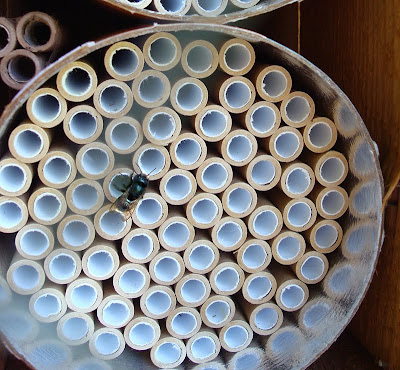
I was amazed to see a second species of mason bee coming and going to my nesting sites. This other species is a soft warm brown color and has a fuzzy overall look, clearly a different solitary bee altogether than the blue orchard mason:
 I asked on a bee forum what species this might be, and it was suggested by a knowledgeable person that it might be Osmia taurus. After looking at many online images I agree that this is likely Osmia taurus. This solitary bee species has no common English name...yet. I think I will invent one for my own use!. It is not one of our native solitary bees, but was imported to Maryland in the northeastern U.S. from China and Japan many years ago and is now established here all over the northeastern U.S. where I live. Unfortunate that there are introduced species around, but not much I can do to change that ...so the welcome mat on my little bee inns will remain for all little bees who need an abode. In that same photo you can also see the black feet of a blue orchard bee (Osmia lignaria) peeking out from one of the other tubes.
I asked on a bee forum what species this might be, and it was suggested by a knowledgeable person that it might be Osmia taurus. After looking at many online images I agree that this is likely Osmia taurus. This solitary bee species has no common English name...yet. I think I will invent one for my own use!. It is not one of our native solitary bees, but was imported to Maryland in the northeastern U.S. from China and Japan many years ago and is now established here all over the northeastern U.S. where I live. Unfortunate that there are introduced species around, but not much I can do to change that ...so the welcome mat on my little bee inns will remain for all little bees who need an abode. In that same photo you can also see the black feet of a blue orchard bee (Osmia lignaria) peeking out from one of the other tubes.
Here is an Osmia taurus bee-girl peering out happily from her chosen tube...
 Click on any picture and it will enlarge.
Click on any picture and it will enlarge.
First, I was able to see another blue orchard mason female bee emerge from the cocoon tubes I had purchase. So things are still happening in that department.
But even more exciting is that over the past two days there have been quite a few female mason bees coming to the boxes and going in and out of the new nesting tubes!
Here are two blue orchard mason bee females using the tubes in my drilled wooden nesting block made by Dave at Dave's Bees:


Here is a blue orchard bee going into tubes in my 'can' nesting unit... it's easy to identify the blue orchard mason bees by their beautiful metallic blue sheen and black body:

I was amazed to see a second species of mason bee coming and going to my nesting sites. This other species is a soft warm brown color and has a fuzzy overall look, clearly a different solitary bee altogether than the blue orchard mason:
 I asked on a bee forum what species this might be, and it was suggested by a knowledgeable person that it might be Osmia taurus. After looking at many online images I agree that this is likely Osmia taurus. This solitary bee species has no common English name...yet. I think I will invent one for my own use!. It is not one of our native solitary bees, but was imported to Maryland in the northeastern U.S. from China and Japan many years ago and is now established here all over the northeastern U.S. where I live. Unfortunate that there are introduced species around, but not much I can do to change that ...so the welcome mat on my little bee inns will remain for all little bees who need an abode. In that same photo you can also see the black feet of a blue orchard bee (Osmia lignaria) peeking out from one of the other tubes.
I asked on a bee forum what species this might be, and it was suggested by a knowledgeable person that it might be Osmia taurus. After looking at many online images I agree that this is likely Osmia taurus. This solitary bee species has no common English name...yet. I think I will invent one for my own use!. It is not one of our native solitary bees, but was imported to Maryland in the northeastern U.S. from China and Japan many years ago and is now established here all over the northeastern U.S. where I live. Unfortunate that there are introduced species around, but not much I can do to change that ...so the welcome mat on my little bee inns will remain for all little bees who need an abode. In that same photo you can also see the black feet of a blue orchard bee (Osmia lignaria) peeking out from one of the other tubes.Here is an Osmia taurus bee-girl peering out happily from her chosen tube...
 Click on any picture and it will enlarge.
Click on any picture and it will enlarge.
Labels:
mason and solitary bees
Thursday, April 8, 2010
Kitties.....
 Just thought I'd put up a couple of pictures of our beloved kitties...
Just thought I'd put up a couple of pictures of our beloved kitties...nine year old Pearl, the 'prima donna' silver Main Coon cat is on the left. She mostly puts up with the rambunctious
Suki, on the right, who was adopted from the Humane Shelter only a few months ago.
Suki likes to really 'get in yer face', as you can see here.

Labels:
cats
Friday, April 2, 2010
My mason bees are hatching!
My solitary mason bee cocoons are hatching!!
After 4 days of over 50F in the nesting box out on my kitchen porch, this morning I noticed one of the little mud caps was missing on one of the six cocoon tubes, and I could see the empty chamber. The mud cap had been there intact yesterday. I could faintly hear little clicking noises from the tubes...somebody was inside the tube trying to chew their way out!
Shortly after that, I saw a couple other mud caps coming off in little chunks. I took a flashlight and a magnifying glass and I could see the fuzzy brown movements of a wiggling cocoon inside. By hanging around the box and checking every few minutes, I was able to watch two new adult mason bee males emerge from their cocoons! I had to be very quick with my camera, because once they exited the tube they only sat for a few moments stretching their wings before they took off flying to parts unknown! Here I thought they were supposed to hang around the box waiting for females, but no, they seemed to have an agenda. Maybe they were thirsty or just doing orientation flights?
Anyway, I'm pretty excited to know I was responsible for adding some new little mason bees to my neighborhood. I feel lucky to have seen at least two being born and to have gotten any pictures at all!
I think the rest will likely hatch later today and tomorrow. I hope to see the bees come back and hang around the nesting boxes soon. I'll be watching the garden flowers and the nesting boxes over the coming weeks...
I love that in the close up you can see a little bit of blue metallic sheen on the abdomen of the first male...and look at his little antennae sections! Click on the photos and they will enlarge to see more details.
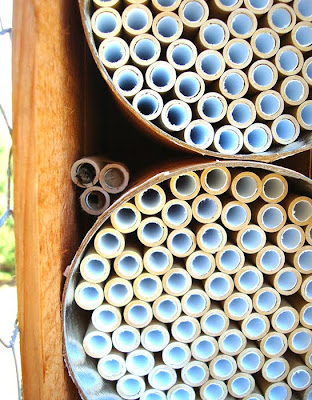



After 4 days of over 50F in the nesting box out on my kitchen porch, this morning I noticed one of the little mud caps was missing on one of the six cocoon tubes, and I could see the empty chamber. The mud cap had been there intact yesterday. I could faintly hear little clicking noises from the tubes...somebody was inside the tube trying to chew their way out!
Shortly after that, I saw a couple other mud caps coming off in little chunks. I took a flashlight and a magnifying glass and I could see the fuzzy brown movements of a wiggling cocoon inside. By hanging around the box and checking every few minutes, I was able to watch two new adult mason bee males emerge from their cocoons! I had to be very quick with my camera, because once they exited the tube they only sat for a few moments stretching their wings before they took off flying to parts unknown! Here I thought they were supposed to hang around the box waiting for females, but no, they seemed to have an agenda. Maybe they were thirsty or just doing orientation flights?
Anyway, I'm pretty excited to know I was responsible for adding some new little mason bees to my neighborhood. I feel lucky to have seen at least two being born and to have gotten any pictures at all!
I think the rest will likely hatch later today and tomorrow. I hope to see the bees come back and hang around the nesting boxes soon. I'll be watching the garden flowers and the nesting boxes over the coming weeks...
I love that in the close up you can see a little bit of blue metallic sheen on the abdomen of the first male...and look at his little antennae sections! Click on the photos and they will enlarge to see more details.




Labels:
mason and solitary bees
Thursday, April 1, 2010
More seeds into the ground
Today was the start of our mini Spring heat wave, a forecast of a whole week of temperatures in the 60's and 70'sF and sunny.
I went out in the vegetable garden again to hoe and plant seeds in a second nine feet section of my 3 foot wide first bed.
Today I added a couple of short rows each of:
Rainbow Swiss chard
Divina butterhead lettuce
Really Red Deer Tongue lettuce
French Breakfast radishes
Calendula flower
Scallions
Bok Choy
Still not seeing any sign of sprouting from my first planting a few days ago.
I also started seeds of Heavenly Blue morning glory, and Only the Lonely tall white nicotiana, in little peat pots indoors
I went out in the vegetable garden again to hoe and plant seeds in a second nine feet section of my 3 foot wide first bed.
Today I added a couple of short rows each of:
Rainbow Swiss chard
Divina butterhead lettuce
Really Red Deer Tongue lettuce
French Breakfast radishes
Calendula flower
Scallions
Bok Choy
Still not seeing any sign of sprouting from my first planting a few days ago.
I also started seeds of Heavenly Blue morning glory, and Only the Lonely tall white nicotiana, in little peat pots indoors
Labels:
gardening
Subscribe to:
Posts (Atom)










